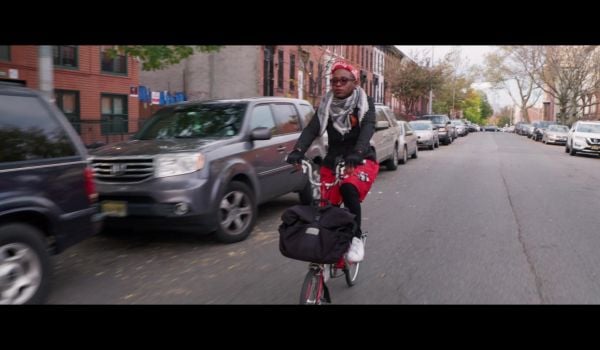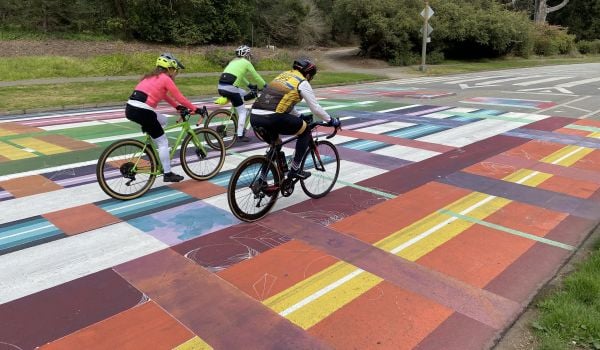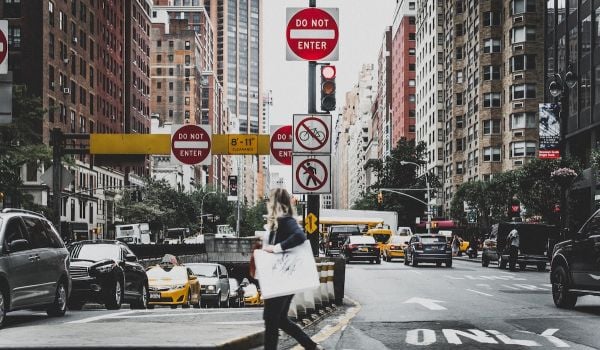Welcome to “The Mobile City,” our weekly roundup of newsworthy transportation developments.
In case you haven’t been paying attention, one of the main goals of the foot soldiers fighting for “the attrition of cars by cities” is to promote walking as essential transportation. The foot is the basic building block of mobility, and a good city neighborhood should make it possible for you to meet all your basic needs on foot. But most of us don’t live in those so-called “15-minute neighborhoods” where one can take care of everything within a 15-minute walk. A mapping software company has developed an app that can help you determine whether your own neighborhood is one of them.
But if the “15-minute neighborhood” is the urbanists’ Holy Grail, even residents of such neighborhoods will no doubt find themselves having to travel beyond them for various reasons. Here, the urbanists’ aim is to minimize the number of such trips that take place behind the steering wheel of a single-occupant car. Tesla Motors founder Elon Musk says he too wants to get people out of “soul-crushing traffic,” but the solution his Boring Company proposed — tunnels for Teslas — raised eyebrows among skeptics who pointed out that cars weren’t capable of carrying as many people as would be needed to reduce traffic on the highway. We now have proof of the error of Musk’s ways from Las Vegas, whose convention center bought Musk’s sales pitch only to find out that those Tesla tunnels couldn’t carry the 4,400 people per hour center officials wanted.
Meanwhile, up on the surface, passenger vehicles, like houses, continue to expand in size, thanks largely to growing consumer preference for SUVs and crossovers. One automaker, Ford, has all but given up on building passenger cars, and most of the others have poured money into producing more and more luxurious car/truck hybrids. One automotive writer recently climbed into the driver’s seat of one of the largest and most luxurious SUVs around, and when he got out, he pronounced it a menace to society — or at least that portion of society that gets around on foot.
Mapping Your “15-Minute Neighborhood” on Your Web Browser
How much can you do by walking for no more than 15 minutes from your front door? Can you do your grocery shopping? Pick up your prescriptions from the drugstore? See your doctor? Find a decent cup of coffee and something good to eat? Go to a train station or bus stop to travel beyond your neighborhood easily?
Functions like these, taken together, define the “15-minute neighborhood.” And Streetsblog USA reports that there’s now a tool that can help you learn whether or not you live in one. Developed by Here Technologies, the “15-minute city app” tells you how many places that fall into one of six categories — culture, education, groceries, leisure, medical and transit — are within a 15-minute walk, 20-minute walk or 15-minute drive of a given location.
Streetsblog’s article points out that the app could serve as a tool to promote more equitable urban development by calling people’s attention to what others might need or want to do within a 15- or 20-minute walk of their homes. “The average college student, for instance, may get by just fine on foot in a neighborhood populated with trendy restaurants, bars, and a few grocery stores, but the single mom next door might be drowning under the costs of maintaining a car that she needs to get her kid to the closest elementary school miles away,” author Kea Wilson writes. “A low-vision person on the same block, meanwhile, might struggle to access a simple park without the help of a sighted driver to take them a few miles down the road, while a twenty-something with 20/20 vision is happy to ride her bike to the same park.”
Here Technologies’ Jordan Stark makes the same point, calling the app “the starting basis for new map tools and data to lay bare gaps in mobility, equity and access.”
Wilson also points out, and Stark acknowledges, that the app needs further refining. For instance, it can’t yet tell you whether you can get to those nearby amenities safely and comfortably on foot. But as both a conversation-starter and a consciousness-raising tool for city dwellers and city planners alike, it already performs a valuable service.
Tesla-Based Transit Rolls Snake Eyes in Vegas
Major conventions often bring the equivalent of a small city to a relatively confined area, namely, a large exhibition hall. And huge halls like the one in Las Vegas can be as daunting to traverse as a 12-lane freeway, only with much slower traffic.
To help convention-goers get around the cavernous Las Vegas Convention Center (LVCC), officials there decided they would need to build a people-mover. To date, most such systems use small rail cars that can carry anywhere from six to 20 people, or even more, operating in a continuous loop at close headways. The most efficient such systems can move more than 4,400 persons per hour.
Which is what LVCC officials wanted from the system they chose. But, TechCrunch reports, the system they chose won’t give them what they want.
That’s because they chose Elon Musk’s underground transit system, which relies on Teslas operating at extremely close headways in tunnels dug by his Boring Company. The Boring Company (TBC) was the low bidder for the LVCC Loop system, which will consist of two 0.8-mile loop tunnels beneath the center. TechCrunch reports that documents it obtained show that the system will move nowhere near the 4,400 persons per hour LVCC officials aksed for and TBC promised.
Failure to deliver the promised capacity consistently will cost TBC big-time, the article notes. The contract between the Las Vegas Convention and Visitors Authority, the center’s owner, and TBC calls for payouts based on meeting certain milestones and penalties for failing to meet promised capacity targets. The COVID-19 pandemic has made meeting project deadlines less urgent — the system was supposed to be ready in time for the 2020 Consumer Electronics Show, one of the biggest exhibitions the center holds, but the pandemic rendered that deatline moot — but even so, TBC still appears to be unable to hit the targets.
Moreover, much of the problems arise from the design and capacity of the stations on the loop. They’re not large enough to handle the hundreds of pasengers per hour that would be needed to meet the 4,400-person-per-hour target.
Which means ongoing penalties for TBC once the system goes into actual service. The contract calls for TBC to pay the LVCVA $300,000 for each event where its system fails to meet the 4,400-persons-per-hour standard for 13 hours, and each repeated failure will trigger additional penalties, up to $4.5 million total.
TBC aims to expand the LVCC Loop system into an actual mass transit system for the city. The article notes that its performance so far could throw those plans into doubt. A link at the end of the article raises similar concerns about a system TBC has proposed to build linking Baltimore and Washington.
Automotive Writer Takes A Scary Ride in a Huge SUV
Critics of sport utility vehicles prefer to call them by another term — “urban assault vehicles,” or UAVs. One of the reasons why they have bestored that term upon them is becaiuse their design and size may make things safer and more comfortable for those inside but put the lives of those they encounter at greater risk of death.
How much greater? A lot, says Andrew J. Hawkins, automotive writer for The Verge. He recently climbed into a 2021 Cadillac Escalade, one of the largest and longest SUVs now being made, and put it through its paces. He writes in his review of the vehicle that it was “one of the most stressful experiences of my life.”
The Escalade, he writes, isolates the driver from the world around them even more than the typical large SUV does. Its high front grille — “like a cliffside,” he writes — makes it impossible to see small children (like his son) in front of the vehicle. The high hood creates a blind spot of 10 feet, 4 inches in front of the car. A local television station, he notes, reported on the blind spot and noted that it would take 13 kindergarteners lined up in front before the driver could see the top of the head of one of them.
This huge piece of front-end real estate also makes the Escalade more dangerous for grown-up pedestrians too. “Larger bodies and higher carriages mean pedestrians are more likely to suffer deadly blows to the head and torso,” he writes. “Higher clearances mean victims are more likely to get trapped underneath a speeding SUV instead of pushed onto the hood or off to the side. Speed is also a factor because SUVs have more horsepower than a typical sedan. A recent investigation by USA Today and the Detroit Free Press found that the growing popularity of SUVs accounts for the alarming rise in pedestrian deaths.”
And the problem is not Cadillac’s alone. The auto industry’s drive to put out bigger and bigger SUVs is makikng these dangers more common as well as bringing with them a host of related lesser problems, such as drivers being unable to stay in their lanes on narrow streets and roads — or even park their vehicles in their garages.
The Escalade is equipped with a battery of cameras and sensors intended to make collisions with pedestrians less likely; GM representatives Hawkins spoke to — one of whom seemed unaware of the blind spot problem — pointed to them with pride when they explained that they we’re making the SUVs bigger in response to consumer demand. But as Hawkins notes, “When you need a suite of high-definition cameras and other expensive sensors to safely drive to the grocery store, there might be something inherently wrong with your design.”
Know of a development that should be featured in this column? Send a Tweet with links to @MarketStEl using the hashtag #mobilecity.

Next City contributor Sandy Smith is the home and real estate editor at Philadelphia magazine. Over the years, his work has appeared in Hidden City Philadelphia, the Philadelphia Inquirer and other local and regional publications. His interest in cities stretches back to his youth in Kansas City, and his career in journalism and media relations extends back that far as well.
Follow Sandy .(JavaScript must be enabled to view this email address)


_600_350_80_s_c1.jpg)


_on_a_Sunday_600_350_80_s_c1.jpeg)










